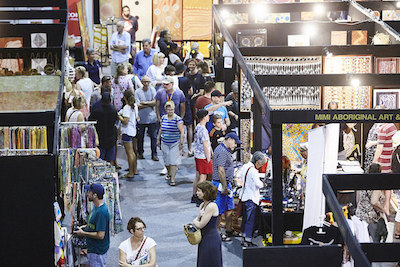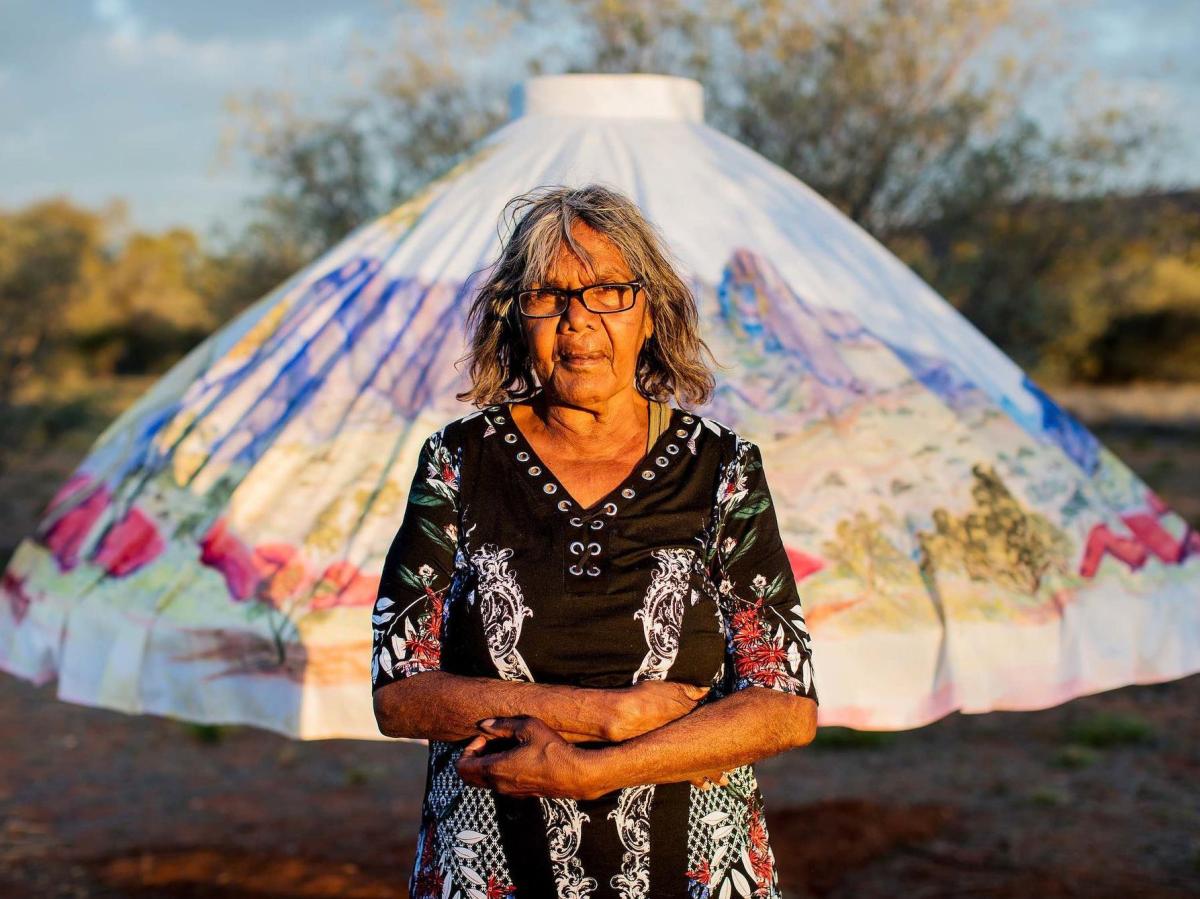Parrtjima, light festival, Alice Springs, 2016. Pictured is artist Lenie Namatjira. Photo: James Horan for AGB Events.
Aboriginal and Torres Strait Islander Art Centres play an vital role in facilitating the development of contemporary Indigenous art. Perhaps even more importantly, these Indigenous owned and operated organisations help ensure that the money generated by the sale of the artwork is ethical, and that the funds are invested back into the communities the centres support.
‘Art buyers need to be made aware of how important it is for them to buy art from an Art Centre, or a gallery that represents an Art Centre,’ said Miriwoong man Ben Ward, an artist from Waringarri Aboriginal Arts in Western Australia.
‘When people buy in this way they should know that the profits from their sales are invested back into the Art Centre and its community, so that we can teach our young people, keep our culture alive, and employ our young people. Also, we are the ones that should be educating people about our culture, that’s why Art Centres are so important.
‘Many people still believe Art Centres are just galleries, but they do so much more than that. Art Centres are here to support the Indigenous community, provide health services, employment services and become advocates for Aboriginal artists who may not know how much their art is worth,’ he said.
Today more than 100 Art Centres are in operation across the country, ensuring Aboriginal artists are paid fairly for their work and Indigenous cultural traditions are preserved and protected. These centres also play an important role in the fight against unfair practices, whereby some unscrupulous dealers pay a small upfront fee to artists only to then resell the work at inflated prices.
National art fairs also help support the work of Art Centres by showcasing their work at events such as Australia’s leading Aboriginal and Torres Strait Islander art event, the 11th Darwin Aboriginal Art Fair (DAAF).
This August a record number of 66 Art Centres from across Australia will be exhibiting their artists’ work at DAAF.
Waringarri Aboriginal Arts became involved in Darwin Aboriginal Art Fair in 2007, and credits the event for taking the careers of several artists, including Ben Ward, to the next level.

2016 Darwin Aboriginal Art Fair. Photo by Shane Eecen.
Ward’s work debuted at Darwin Aboriginal Art Fair in 2015, and sold for approximately $2000. In 2016 the value of his work increased to $3000 for work of the same size (100 x 80cm) and this year his work will be selling for $6000.
‘Darwin Aboriginal Art Fair introduced me to a lot of galleries. My work is now exhibiting in Mossenson Galleries in Perth and it has drawn a lot of popularity for my work. I only wish to sell my work to galleries and Art Centres that are having a direct impact on my community,’ Ward said.
How it works
Art Centres have systems in place to ensure artists are paid ethically. An industry standard ensures artists receive 60% of the sale price, with 40% returning to the Art Centres, to continue their important work in the community.
Darwin Aboriginal Art Fair Foundation (DAAFF) Chair, Franchesca Cubillo, said that by purchasing through events such as Darwin Aboriginal Art Fair, collectors were ensuring the profits are fairly distributed between the artist and the Indigenous owned and operated Art Centres.
‘We support the work of more than 2000 artists at DAAF each year, and 100% of the sales return directly to Aboriginal and Torres Strait Islander communities,’ Cubillo said.
‘In 2016, DAAF raised more than $2.038 million in one weekend for remote communities.’
This year’s program will continue to expand the activities that were piloted in 2016 as part of the Fair’s 10th anniversary celebrations, and include a high-end fashion runway show, an Indigenous film gala, and a panel discussion.
The foundation will again present the fashion show From Country to Couture in 2017, celebrating the fusion of Aboriginal and Torres Strait Islander contemporary fine art with high end fashion.
The 2017 panel discussion commemorates the 50th anniversary of the 1967 Referendum granting Indigenous Australians the right to be counted as Australians for the first time, and the 25th anniversary of the 1992 Mabo High Court judgement. Leading the panel will be Gail Mabo, Djon Mundine, and Marcia Langton.
The DAAF Foundation will also showcase the evolving film culture in Aboriginal and Torres Strait Islander communities with an Indigenous film gala held at Darwin’s iconic Deckchair Cinema. The DAAF film gala features the Northern Territory launch of Namatijira Project, the true story of Indigenous artist Albert Namatjira and his family’s fight to gain back the copyright on his artwork, a highly appropriate subject to lead a national event that has always had fairness for Indigenous artisans at its heart.
Darwin Aboriginal Art Fair runs from Friday 11 August – Sunday 13 August at Darwin Convention Centre.
For further information visit www.darwinaboriginalartfair.com.au





